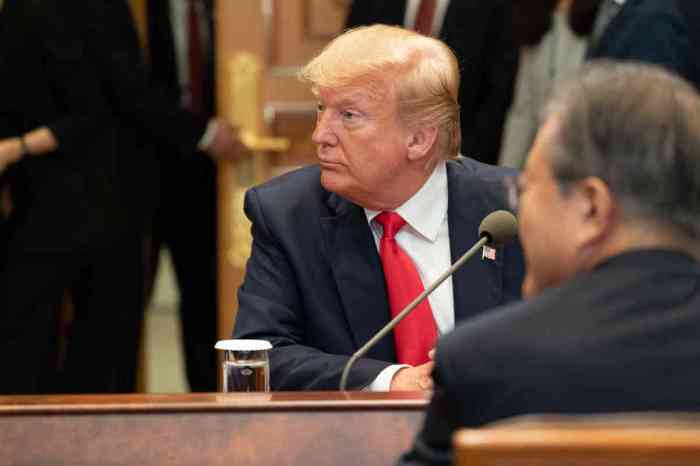Apparently irked by lower federal courts refusing to let President Donald Trump’s transgender military ban go into effect, the administration, represented by Solicitor General Noel J. Francisco, has peppered the Supreme Court with petitions and motions seeking to short-circuit the normal litigation process and allow the ban to go into effect while lawsuits in numerous district and appellate courts grind on.
Impatient that two circuit courts of appeals had not ruled on the government’s motions to dissolve four nationwide preliminary injunctions issued a year ago blocking the ban, Francisco filed petitions in three pending cases on November 23, asking the court to take those appeals directly and decide them in the term running through June of next year. Then, on December 13, Francisco filed motions in all three cases asking the court to stay the preliminary injunctions — even if it decides not to take on the cases for review now — so that the policy can go into effect right away. As a last-ditch move, Francisco also asked that if the court were unwilling to stay the injunctions, it at least narrow them so they apply only to the specific plaintiffs in the three cases.
Trump announced his ban in a series of three tweets in July 2017. Defense Secretary James Mattis, who was on vacation at the time, is reported to have first learned about the president’s idea the prior evening, and the Pentagon was caught by surprise, unable to answer journalists’ inquiries the next day. With the government stonewalling against discovery requests in the pending cases, district judges have suggested there was no factual basis for the ban.
Indeed, press reports in the weeks following its announcement suggested it was entirely political, Trump’s response to demands by some conservative House Republicans that he take action to prevent federal funds being spent on gender transition procedures for military personnel. Those members threatened the president with blocking an appropriations bill — which he hoped would include funding for his border wall — if he didn’t take action. Banning transgender people from serving in the military was his response, according to these accounts.
Litigation followed in four federal district courts, resulting within months in all four trial judges granting the plaintiffs’ motions for preliminary injunctions to stop the ban from going into effect while the litigation was going on. In each case, the plaintiffs persuaded the judge they were likely to succeed in proving the ban was unconstitutional, that blocking it was not harmful to the national interest, and that letting it go into effect would cause irreparable harm to them. Several judges held that a policy that discriminates against transgender individuals is subject to an intermediate level of judicial scrutiny under the Fifth Amendment’s equal protection requirement — meaning the policy is presumed unconstitutional and the government bears the burden of showing it substantially advances an important public interest.
Judge Marsha Pechman of the Western District of Washington went further, finding gender identity discrimination involves a “suspect classification” subject to strict judicial scrutiny. The burden in such cases is higher — the government must show the policy is necessary to achieve a compelling government interest.
So, while Defense Secretary Mattis pursued Trump’s charge to devise an implementation plan for the ban by February 2018, the Pentagon was required to allow transgender individuals to enlist as of this past January 1. That date represented Mattis’ earlier six-month delay of Obama Defense Secretary Ash Carter’s deadline for opening up service to trans personnel. The Pentagon under Carter concluded that banning transgender people from serving in the military was generally unjustified, although he set some criteria for determining which trans people should be allowed to serve.
Mattis’ February plan was a revised version of the policy Trump described in an August 2017 memorandum that followed his tweets. The Mattis plan was purportedly based on the findings of a new policy review undertaken by a special Task Force he appointed, but whose members remained anonymous to the public. Mattis claimed to shift the focus of the ban from transgender identity to individuals diagnosed with gender dysphoria, and so he claimed his “new” policy was not a “transgender ban” but rather a ban on individuals suffering a diagnosable mental condition disqualifying for military service, though it “grandfathered” transgender personnel who had identified themselves and transitioned after Secretary Carter ended the prior ban effective July 1, 2016.
With the announcement of Mattis’ policy, the administration filed motions in all four pending lawsuits to dissolve the preliminary injunctions, arguing they were directed against Trump’s August 2017 memorandum and not the Mattis policy. Since that policy purported to be based on a diagnosable mental condition, the government argued, it does not get heightened scrutiny and is not presumptively unconstitutional, and the government has no burden to justify it. The Mattis policy is entitled to the traditional deference federal courts pay to military personnel policies, the administration argued.
Three of the district judges — in Seattle, Riverside, and Washington, DC, rejected the government’s motions to dissolve the preliminary injunctions, seeing the administration’s semantic game for what it is. The Mattis plan was developed on orders from Trump to implement his ban, and with minor exceptions, the “new” policy is merely a restatement of the one Trump tweeted and has the same effect. The government has appealed those three cases.
The Ninth Circuit Court of Appeals heard arguments in the cases from Washington and California in October, and the DC Circuit heard arguments on December 10. Both courts of appeals could issue decisions at any time, but the impatient administration, perhaps anticipating that its appeals will be unsuccessful, filed its petitions on November 23 urging the Supreme Court to intervene immediately.
In the fourth case, pending in the District Court in Baltimore, the judge who issued the preliminary injunction retired in June, and the judge who took over has not ruled on the government’s motion. However, in a November 30 ruling on discovery matters, that judge clearly signaled he will likely join his three colleagues from the other district courts in denying the motion, in which case the government would be filing an appeal in the Fourth Circuit, too.
In his recent filings to the Supreme Court, Solicitor General Francisco argues as if there is an emergency to national security that requires the Defense Department to start dismissing transgender troops and suspending the enlistment of new trans personnel as quickly as possible. At the same time, they appear to be deceptive and revisionist accounts of the Trump administration’s history on this issue. Though Trump’s initial tweets stated a categorical ban on transgender individuals serving in the military, Francisco’s account suggests this was not a ban at all, projecting backwards from Mattis’ semantic sleight-of-hand. And Francisco implies that Mattis’ directive at the end of June 2017 to delay by six months former Secretary Carter’s date for lifting the ban on trans enlistment to study implementation issues was actually setting in motion a complete re-evaluation of Carter’s policy decision and so provided the basis for Trump’s tweets and his August 2017 memorandum that followed.
This framing clearly aims to undermine the findings by the trial judges that the Trump ban was implemented without any professional military expertise and that the Task Force Mattis appointed in the fall of 2017 was intended to provide an after-the-fact justification for Trump’s politically-motivated policy declarations.
Francisco insistently presses for speedy action by the Supreme Court, clearly mindful of the schedule that currently lists April 24 as the last day for argument in the term ending in June. And Francisco is asking that his motions for staying the injunctions be taken up together with his petitions for high court review of the underlying merits of the cases, most likely at the court’s January 11 conference.
Francisco has also mounted an attack on the nationwide preliminary injunctions, emphasizing a controversy over the ability of a single district judge to issue an order suspending a federal policy on a nationwide basis. He contends that in fewer than two full years, the Trump administration has suffered 25 nationwide injunctions from federal district courts, and argued that the situation is out of control. These injunctions involve attempts by the Trump administration to abruptly change significant federal policies without congressional authorization and frequently in violation of requirements of the Administrative Procedure Act, in ways that will inflict irreparable injury on many people. But some Supreme Court justices have signaled their uneasiness about nationwide injunctions by federal district judges, and Francisco appeals to this uneasiness.
Once the court receives the plaintiffs’ responses, due within weeks, it will be presented with a very different account, contradicting Francisco’s revisionist history at many turns. The Ninth and DC Circuits may issue their decisions before the Supreme Court conferences these cases, likely adding more voices to discredit the dishonest position taken by the administration ever since Trump first tweeted his ban.



































